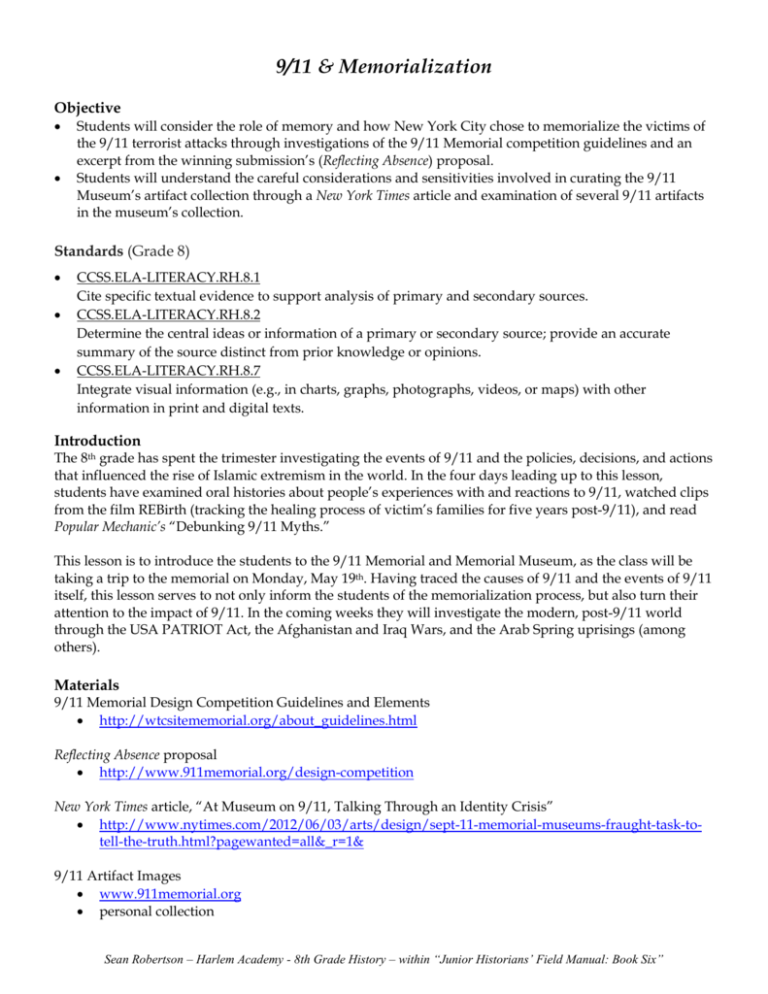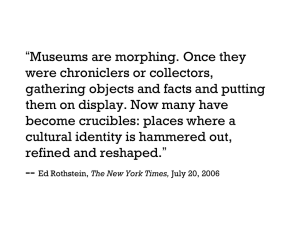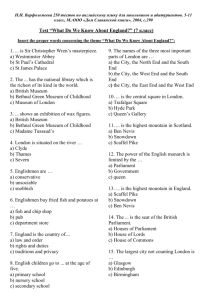File - Junior Historians
advertisement

9/11 & Memorialization Objective Students will consider the role of memory and how New York City chose to memorialize the victims of the 9/11 terrorist attacks through investigations of the 9/11 Memorial competition guidelines and an excerpt from the winning submission’s (Reflecting Absence) proposal. Students will understand the careful considerations and sensitivities involved in curating the 9/11 Museum’s artifact collection through a New York Times article and examination of several 9/11 artifacts in the museum’s collection. Standards (Grade 8) CCSS.ELA-LITERACY.RH.8.1 Cite specific textual evidence to support analysis of primary and secondary sources. CCSS.ELA-LITERACY.RH.8.2 Determine the central ideas or information of a primary or secondary source; provide an accurate summary of the source distinct from prior knowledge or opinions. CCSS.ELA-LITERACY.RH.8.7 Integrate visual information (e.g., in charts, graphs, photographs, videos, or maps) with other information in print and digital texts. Introduction The 8th grade has spent the trimester investigating the events of 9/11 and the policies, decisions, and actions that influenced the rise of Islamic extremism in the world. In the four days leading up to this lesson, students have examined oral histories about people’s experiences with and reactions to 9/11, watched clips from the film REBirth (tracking the healing process of victim’s families for five years post-9/11), and read Popular Mechanic’s “Debunking 9/11 Myths.” This lesson is to introduce the students to the 9/11 Memorial and Memorial Museum, as the class will be taking a trip to the memorial on Monday, May 19th. Having traced the causes of 9/11 and the events of 9/11 itself, this lesson serves to not only inform the students of the memorialization process, but also turn their attention to the impact of 9/11. In the coming weeks they will investigate the modern, post-9/11 world through the USA PATRIOT Act, the Afghanistan and Iraq Wars, and the Arab Spring uprisings (among others). Materials 9/11 Memorial Design Competition Guidelines and Elements http://wtcsitememorial.org/about_guidelines.html Reflecting Absence proposal http://www.911memorial.org/design-competition New York Times article, “At Museum on 9/11, Talking Through an Identity Crisis” http://www.nytimes.com/2012/06/03/arts/design/sept-11-memorial-museums-fraught-task-totell-the-truth.html?pagewanted=all&_r=1& 9/11 Artifact Images www.911memorial.org personal collection Sean Robertson – Harlem Academy - 8th Grade History – within “Junior Historians’ Field Manual: Book Six” Procedure Investigation Question and Teaching Point How should we memorialize the events of September 11th, 2001? o Identify and explain the considerations and decisions made in creating the 9/11 Memorial and Museum. Do Now Students consider the role and purpose of memorials and museums (in general) by responding to the following prompts: o What is a memorial? o What is the purpose of a memorial? Examples? o Why do we memorialize things? o What do we memorialize? o What is the purpose of a museum? o Why do people go to museums? Examples? Do Now Share Students share and explain their responses Introduction – 9/11 Memorial Teacher provides context for the lesson: o “Memory is as the affection: we remember the things which we love and the things which we hate.” Ralph Waldo Emerson o The push to memorialize the WTC site began almost as soon as the debris had been removed. The cleanup of the 1.8 million tons of rubble and debris was a painstaking process as each piece of debris had to be carefully sifted and preserved as there were so many personal effects and human remains mixed in. A tiny fraction of that material was selected for possible use in a future museum and kept at Hangar 17 at John F. Kennedy International Airport. Eventually, more than 1,200 pieces of steel, as well as other objects, filled the 80,000 square feet of Hangar 17. The last piece of debris was removed from the Ground Zero site on May 20th, 2002 and the process of rebuilding began. The root of the term memorial is in the idea of memory. The city and nation, faced with how to memorialize, met disagreement and varying opinions. The decision was made to create an open contest to solicit ideas for a new memorial at the Ground Zero site, where the Twin Towers had once stood. o 9/11 Memorial Students review the 9/11 Memorial Commission’s Guidelines (excerpted) for project submissions Students review the proposal from Reflecting Absence, the winning submission Students complete a graphic organizer listing the guidelines that were met by the submission and note specific evidence from the text to support their claims Introduction – 9/11 Memorial Museum Teacher provides context for the lesson: o On Thursday, May 15th, 2014, the 9/11 Memorial Museum opened to the victim’s families and survivors of the attacks. The museum will open to the public on Wednesday, May 21st. In the intervening twelve plus years since the attacks there has been much debate and controversy over what should and what should not be included in the museum’s exhibits. Sean Robertson – Harlem Academy - 8th Grade History – within “Junior Historians’ Field Manual: Book Six” 9/11 Memorial Museum Students read NYT article (“At Museum on 9/11, Talking Through an Identity Crisis”) Students record considerations, goals, sensitivities, and the mission of the museum as stated in the article Students work in pairs to examine two artifacts (12 total) to determine the overall benefits and detractions from including such an item in the museum’s exhibit halls. o Detailed description of the artifact o What does this artifact communicate about the events of 9/11? o Could this artifact be considered controversial or sensitive? How or why? o How might a visitor view, respond, reflect, and or interact with this artifact in the museum? o What possible value does this artifact have for the museum? What recorded criteria does this artifact meet? o Should this artifact be included in the museum’s exhibit halls? Wrap-Up Students present their artifacts and decisions for class discussion Exit Ticket – Demonstration of Understandings Students utilize their lesson investigation answers to compose a response to the day’s Investigation Question Enrichment and Digging Deeper After the class field trip to the 9/11 Memorial site, they will record their reflections on the experience and how the memorial captured the spirit of the guidelines presented at the outset of the lesson. Sean Robertson – Harlem Academy - 8th Grade History – within “Junior Historians’ Field Manual: Book Six”







